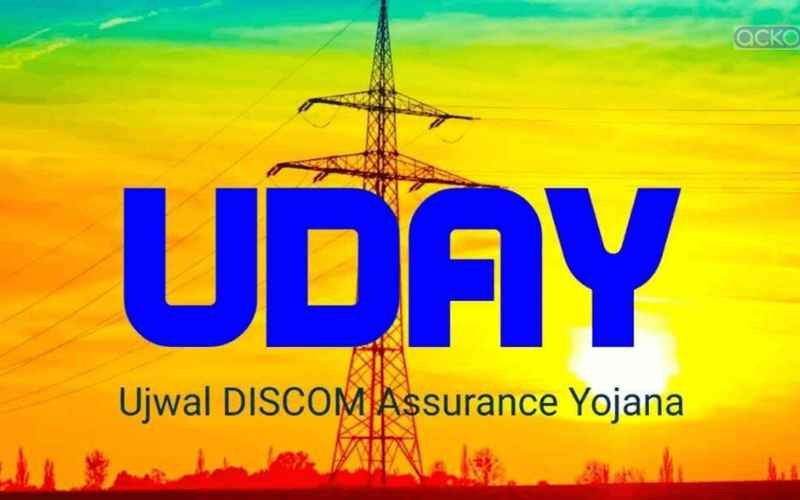In a significant move to address the financial woes of the power distribution companies (DISCOMs) and to revive the power sector, the Government of India launched the Ujwal DISCOM Assurance Yojana (UDAY) on 20th November 2015. The scheme aims to provide a comprehensive and sustainable solution to the problems faced by DISCOMs, ensuring efficient and reliable power supply across the country.

Objectives of UDAY
Financial Turnaround:
The primary objective of UDAY (Ujwal DISCOM Assurance Yojana) is to enhance the financial health of Distribution Companies (DISCOMs). The scheme allows state governments to take over 75% of the debts of DISCOMs, significantly reducing the interest burden on these companies. This debt restructuring improves the financial stability of DISCOMs, enabling them to operate more efficiently and invest in better infrastructure and services.
Operational Efficiency:
UDAY aims to improve the operational efficiency of DISCOMs through several key measures:
- Feeder and Distribution Transformer Metering: Implementing mandatory metering of feeders and distribution transformers helps in better monitoring and management of electricity distribution, reducing losses.
- Consumer Indexing: By indexing consumers, DISCOMs can ensure accurate billing and reduce instances of power theft and non-payment.
- Infrastructure Upgradation: Upgrading or replacing outdated infrastructure, such as old transformers and cables, helps in reducing Aggregate Technical & Commercial (AT&C) losses, which are a major issue for DISCOMs.
Reduction of Cost of Power:
Another critical objective of UDAY is to reduce the cost of power generation. This is achieved through several strategies:
- Use of Low-Cost Fuel: Promoting the use of cheaper and more efficient fuel sources helps in reducing the overall cost of power production.
- Efficiency Improvements: Enhancing the efficiency of existing power plants through technological upgrades and better management practices.
- Renewable Energy Promotion: Encouraging the adoption of renewable energy sources, which can provide a more cost-effective and sustainable power supply in the long term.
Development of Renewable Energy:
UDAY places a significant emphasis on increasing the generation capacity of renewable energy sources. This focus not only contributes to a cleaner environment but also helps in reducing the dependency on fossil fuels. By promoting the use of renewable energy, UDAY aims to create a sustainable and environmentally friendly energy sector in India.
Key Features
Debt Restructuring:
- State Takeover of Debt: States are responsible for taking over 75% of the debt of their respective DISCOMs as of 30th September 2015.
- Conversion of Remaining Debt: The remaining 25% of the debt will be converted into low-interest bonds. This restructuring aims to ease the financial burden on DISCOMs and improve their fiscal health.
Reduction in AT&C Losses:
- Target Reduction: The scheme sets a target to reduce Aggregate Technical & Commercial (AT&C) losses to 15% by the fiscal year 2018-19. Achieving this target will enhance the overall efficiency and profitability of DISCOMs.
Reduction in Interest Cost:
- Lower Interest Bonds: The debt taken over by the states will be converted into bonds with a lower interest rate. This conversion is expected to result in significant savings for DISCOMs, allowing them to allocate more resources towards operational improvements and service delivery.
Operational Efficiency Initiatives:
- Smart Metering: Implementation of smart meters helps in accurate measurement and billing, reducing losses due to theft and inaccuracies.
- Feeder Separation: Segregating agricultural and non-agricultural feeders ensures a more reliable and efficient power supply.
- Transformer Upgradation: Upgrading transformers helps in reducing technical losses and improving power quality.
- Billing and Collection Efficiency: Improving billing and collection processes ensures timely revenue realization and reduces losses due to non-payment.
Promotion of Renewable Energy:
- Encouragement of Solar and Wind Projects: States are encouraged to promote the development of solar and wind energy projects.
- Increasing Renewable Share: The aim is to increase the share of renewables in the energy mix, contributing to a sustainable and environmentally friendly power sector.
Implementation and Impact
Mixed Impact: Since its inception, UDAY has had varied results across different states. While some states have shown notable improvements in the financial and operational parameters of their DISCOMs, others continue to face significant challenges. The scheme has underscored the necessity for comprehensive reforms in the power sector and has paved the way for future initiatives aimed at enhancing the sector’s overall efficiency and sustainability.
Success Stories:
- Gujarat, Maharashtra, and Karnataka: These states have made significant progress under UDAY, particularly in reducing AT&C losses and improving the financial health of their DISCOMs. Their success can be attributed to effective implementation of operational efficiency measures and strong administrative support.
- Renewable Energy: UDAY’s emphasis on promoting renewable energy has resulted in a substantial increase in the installed capacity for solar and wind energy. This shift towards renewables not only contributes to a cleaner environment but also helps in reducing dependency on fossil fuels and lowering power generation costs.
Challenges:
- Implementation Issues: Some states have faced difficulties in implementing the necessary reforms due to political and administrative hurdles. These challenges have hindered the progress of UDAY in certain regions.
- Financial Restructuring Insufficiency: While financial restructuring has provided some relief, it has not been enough to address the deep-rooted issues in several DISCOMs. Persistent problems such as inefficient operations, poor infrastructure, and lack of regulatory support necessitate further, more comprehensive reforms to achieve the desired outcomes.
Overall, UDAY has highlighted both the potential for improvement in the power sector and the ongoing challenges that need to be addressed. The scheme’s mixed impact underscores the importance of tailored approaches and sustained efforts to drive meaningful change across different states.
Conclusion
UDAY Yojana marks a pivotal step in the transformation of India’s power sector. By addressing the financial and operational challenges faced by DISCOMs, the scheme aims to ensure a sustainable and reliable power supply to all. While the journey has its set of challenges, the lessons learned from UDAY will undoubtedly pave the way for more robust and effective reforms in the future.
Top 20 FAQs about UDAY Yojana
- What is UDAY Yojana?
- UDAY (Ujwal DISCOM Assurance Yojana) is a government initiative launched on 20th November 2015 to improve the financial and operational efficiency of power distribution companies (DISCOMs) in India.
- What are the primary objectives of UDAY?
- The main objectives are financial turnaround of DISCOMs, operational efficiency improvement, reduction in the cost of power, and promotion of renewable energy.
- How does UDAY aim to achieve financial turnaround?
- States take over 75% of DISCOM debt, converting it into state government bonds with lower interest rates, thereby reducing the interest burden on DISCOMs.
- What measures are taken to improve operational efficiency under UDAY?
- Measures include smart metering, feeder separation, transformer upgrades, consumer indexing, and reducing Aggregate Technical & Commercial (AT&C) losses.
- How does UDAY help in reducing the cost of power?
- By promoting the use of low-cost fuel, improving the efficiency of existing plants, and encouraging renewable energy sources.
- What is the target for AT&C losses reduction under UDAY?
- The target is to reduce AT&C losses to 15% by 2018-19.
- How does UDAY promote renewable energy?
- By encouraging states to increase the share of solar and wind energy in their power generation mix.
- What are the key features of UDAY?
- Debt restructuring, reduction in AT&C losses, reduction in interest costs, operational efficiency initiatives, and promotion of renewable energy.
- How does UDAY benefit consumers?
- By ensuring a more reliable and efficient power supply, reducing power outages, and potentially lowering electricity tariffs in the long run.
- What challenges does UDAY face?
- Challenges include political and administrative hurdles, deep-rooted financial issues in some DISCOMs, and varying levels of success among different states.
- Which states have shown significant improvement under UDAY?
- States like Gujarat, Maharashtra, and Karnataka have made notable progress in reducing AT&C losses and improving the financial health of their DISCOMs.
- How does UDAY impact the environment?
- By promoting renewable energy, UDAY contributes to a cleaner environment and reduces dependency on fossil fuels.
- What is the role of the central government in UDAY?
- The central government provides guidelines, monitors progress, and offers financial incentives to states for achieving targets under UDAY.
- Can UDAY help in achieving 24×7 power for all?
- Yes, by improving the financial and operational health of DISCOMs, UDAY aims to ensure continuous and reliable power supply for all.
- How are consumers affected by the implementation of smart metering under UDAY?
- Smart metering helps in accurate billing, reducing power theft, and providing consumers with better control over their electricity usage.
- What financial savings are expected from UDAY?
- Significant savings in interest costs and reduction in losses are expected to improve the overall financial health of DISCOMs.
- What is the role of state governments in UDAY?
- State governments are responsible for taking over DISCOM debts, implementing operational efficiency measures, and promoting renewable energy projects.
- How does UDAY address the issue of power theft?
- Through smart metering, consumer indexing, and stricter enforcement of regulations, UDAY aims to reduce power theft significantly.
- What are the long-term benefits of UDAY?
- Long-term benefits include a financially stable power sector, improved operational efficiency, reduced power losses, and increased adoption of renewable energy.
- Is UDAY a permanent solution to the problems faced by DISCOMs?
- While UDAY provides a significant step towards addressing the issues, continuous reforms and monitoring are required to ensure sustainable improvements in the power sector.















